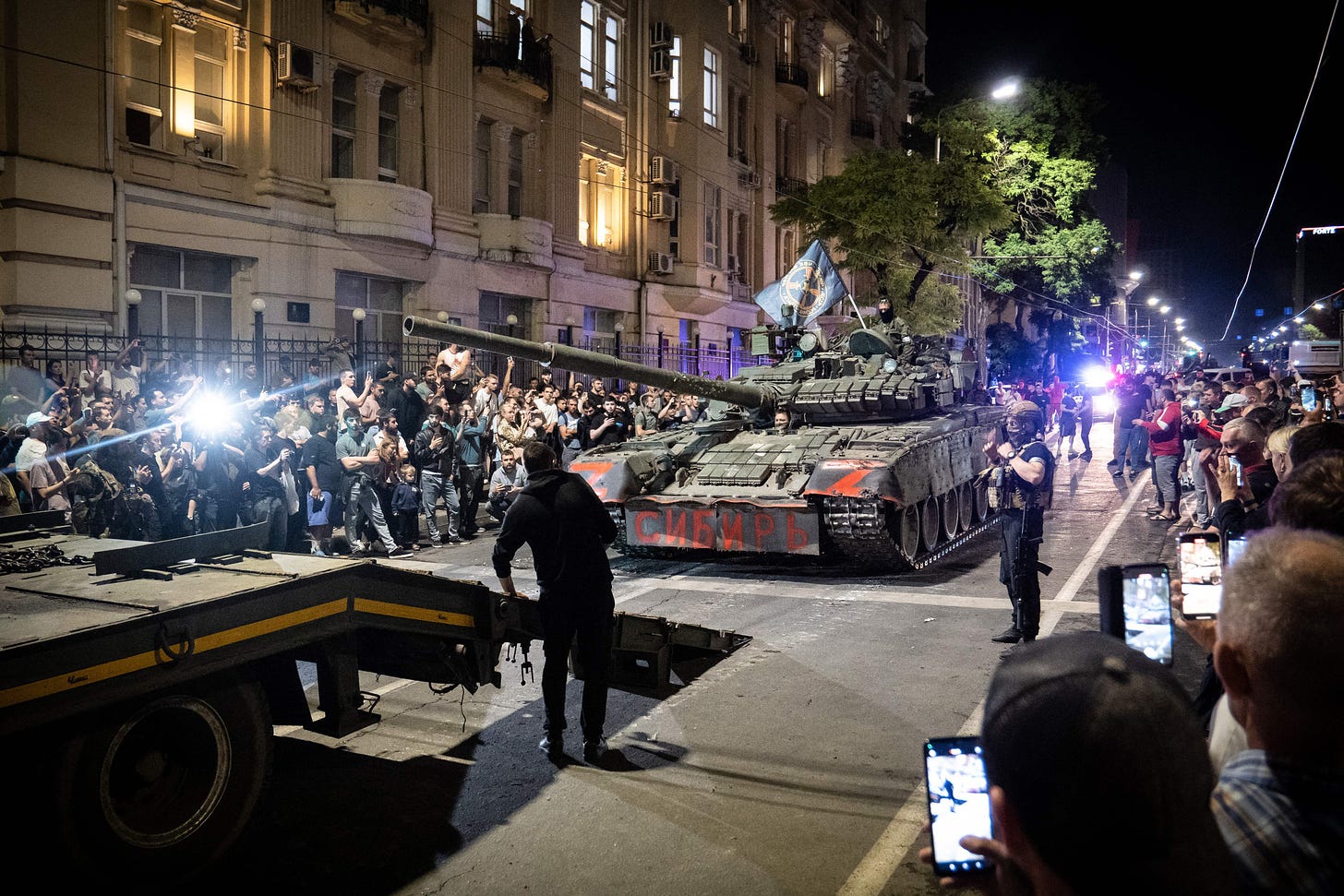What Next?: Strategy After the Prigozhin Mutiny
The United States should exploit the weakness Prigozhin demonstrated in Russia.

L’affaire Prigozhin will have at least one durable effect: It reveals the fragility of Vladimir Putin’s project of Russian revanche. What we just witnessed presages, as did the events of 1989, another large-scale implosion of the Russian empire. The question now—as then—is whether the United States and its allies can comprehend the historical moment and make the most of it.
For a host of reasons—not only George H.W. Bush’s natural pragmatism and strategic caution, the delicacy of reuniting Germany within NATO, and the hope that Russia would reform itself but also exogenous events like Iraq’s invasion of Kuwait—Bush and his successors did not realize the dream of “Europe whole and free.” History had ended and its arc bent ineluctably toward liberty and prosperity.
From the moment he rose to power in Moscow, Putin has strained to rebuild a Russian empire to reverse the global tide of Westernization. His first move was to reestablish the power of the central government over breakaway regions and peoples, most notably in the Chechen wars but also including continued support for Armenia’s irredentist claims to the Nagorno-Karabakh region of Azerbaijan.
Step two was marked by the limited invasions of Georgia in 2008 and Ukraine in 2014 and a return, in 2015, to the Middle East with direct military support to the Assad regime in Syria. These first two steps demonstrated the brutality of Russian military operations but were likewise widely interpreted as evidence of military modernization and sophistication, combining advanced battlefield tactics with “information warfare” in the “gray zone.” These also won Putin a reputation as a master strategist worthy of a central position in international power politics.
Step three, the renewed invasion of Ukraine in February 2022, has gradually stripped away these pretensions until, post-Prigozhin, Emperor Putin stands all but naked. His grip on his own people has slipped, even if he somehow disposes of Chef Yevgeny. Russian armed forces have been exposed as a small and brittle shell, incapable of complex, sustained operations. Rather than halting NATO enlargement, the Russo-Ukraine War has encouraged it and—especially in the form of the Polish armed forces—strengthened it. And, most ominously for Moscow, the United States has been drawn back toward engagement in European security affairs.
Alas, until now the Biden administration has looked backward rather than forward, seeking the stability of familiarity rather the opportunities that beckon, nostalgic for the Europe that was (or seemed to be) instead of embracing the Europe that can be. The restoration of Ukrainian sovereignty and liberty would be a start, not the conclusion; Putin’s attacks are merely campaigns in his larger war, not the war itself. We must recognize the nature of this conflict to act properly.
This will demand a strategy that works to accelerate the dissolution of the Russian empire—or, as Ronald Reagan might have said, “rollback” rather than containment. The view of so-called foreign-policy realists that Moscow has a legitimate sphere of interest in its “near abroad” is deeply wrong. Legitimacy is a measure of political principle—that is, liberal, representative governance; influence is a measure of power. Russia fails on both counts. And Russia’s failures are for Russians to remedy.
The United States and NATO must begin to look beyond Ukraine, even as Kyiv is invited to join the alliance at the earliest moment; bilateral security guarantees are but a halfway house. NATO membership should be extended not only to Ukraine but also to Georgia. The Russian-occupied territories of South Ossetia, Abkhazia, and Transnistria should be freed. Russian forces should further withdraw from Kaliningrad and Belarus, and a sizable “demilitarized zone” established where Russia shares a border with the Atlantic alliance. Russian provocations in Nagorno-Karabakh must cease and Azerbaijan’s sovereignty must be recognized.
These further steps will require strategic patience and constant attention on the part of America and its allies; Washington must remember how to be a truly global power. NATO naval strategy must account for the security of the Arctic, Baltic, and Black Seas as well as the Mediterranean and the North Atlantic. The terrestrial “Eastern Front” extends roughly 4,000 miles from Lapland to Tbilisi. The previous alliance benchmark—still to be reached—of every member state allocating 2 percent of its national economic production to defense spending is outdated and too low: Poland has declared that it will ramp up to 3 percent, and that should be the new standard for Europe.
In this regard, the United States must cure itself of its strategic China monomania. Not only is the danger from Russia more acute and immediate, but the rewards of Russian imperial implosion are great. The collapse of the Russian empire is something Beijing cannot ignore: China is first and foremost a continental Eurasian before an “Indo-Pacific” and maritime power. It remains to be seen how Beijing will regard Russia’s newly revealed weakness, but it is as likely to act as a predator in the Russian Far East and Central Asia than Moscow’s protector. And cementing Southeast Europe into the West would open prospects for renewed Western influence in the Caucasus and Central Asia; the Silk Road can run in both directions.
Prigozhin has shown us the man and the wheezing contraption behind the Russia curtain. Beyond the immediate chaos, the Russian fossil fuel economy and national demographics increase the likelihood of further collapse. Yes, Moscow still has lots of nukes, but they neither give Putin what he wants abroad nor prevent the rot at home. Indeed, L’affaire Prigozhin suggests that the meltdown may come sooner rather than later. We were caught by surprise in 1991; shame on us if we are surprised again.




